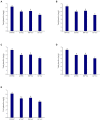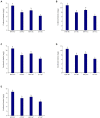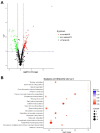Heat wave event facilitates defensive responses in invasive C3 plant Ambrosia artemisiifolia L. under elevated CO2 concentration to the detriment of Ophraella communa
- PMID: 35968104
- PMCID: PMC9363847
- DOI: 10.3389/fpls.2022.907764
Heat wave event facilitates defensive responses in invasive C3 plant Ambrosia artemisiifolia L. under elevated CO2 concentration to the detriment of Ophraella communa
Abstract
To predict and mitigate the effects of climate change on communities and ecosystems, the joint effects of extreme climatic events on species interactions need to be understood. Using the common ragweed (Ambrosia artemisiifolia L.)-leaf beetle (Ophraella communa) system, we investigated the effects of heat wave and elevated CO2 on common ragweed growth, secondary metabolism, and the consequent impacts on the beetle. The results showed that elevated CO2 and heat wave facilitated A. artemisiifolia growth; further, A. artemisiifolia accumulated large amounts of defensive secondary metabolites. Being fed on A. artemisiifolia grown under elevated CO2 and heat wave conditions resulted in the poor performance of O. communa (high mortality, long development period, and low reproduction). Overall, under elevated CO2, heat wave improved the defensive ability of A. artemisiifolia against herbivores. On the other hand, enhanced adaptability to climatic changes may aggravate invasive plant distribution, posing a challenge to the control of invasive plants in the future.
Keywords: Ophraella communa; biological invasions; climate change; common ragweed; herbivore; invasive plant; secondary metabolite.
Copyright © 2022 Tian, Ma, Zhao, Zhang, Gao, Tian, Chen, Guo and Zhou.
Conflict of interest statement
The authors declare that the research was conducted in the absence of any commercial or financial relationships that could be construed as a potential conflict of interest.
Figures





Similar articles
-
Transcriptome Analysis of Ophraella communa Male Reproductive Tract in Indirect Response to Elevated CO2 and Heat Wave.Front Physiol. 2020 May 5;11:417. doi: 10.3389/fphys.2020.00417. eCollection 2020. Front Physiol. 2020. PMID: 32431624 Free PMC article.
-
Host-Plant Selection Behavior of Ophraella communa, a Biocontrol Agent of the Invasive Common Ragweed Ambrosia artemisiifolia.Insects. 2023 Mar 29;14(4):334. doi: 10.3390/insects14040334. Insects. 2023. PMID: 37103149 Free PMC article.
-
Investigating the Current and Future Co-Occurrence of Ambrosia artemisiifolia and Ophraella communa in Europe through Ecological Modelling and Remote Sensing Data Analysis.Int J Environ Res Public Health. 2019 Sep 14;16(18):3416. doi: 10.3390/ijerph16183416. Int J Environ Res Public Health. 2019. PMID: 31540033 Free PMC article.
-
When a plant invader meets its old enemy abroad: what can be learnt from accidental introductions of biological control agents.Pest Manag Sci. 2024 Jan;80(1):19-27. doi: 10.1002/ps.7390. Epub 2023 Feb 10. Pest Manag Sci. 2024. PMID: 36710367 Review.
-
Ragweed is in the Air: Ambrosia L. (Asteraceae) and Pollen Allergens in a Changing World.Curr Protein Pept Sci. 2023;24(1):98-111. doi: 10.2174/1389203724666221121163327. Curr Protein Pept Sci. 2023. PMID: 36411556 Review.
Cited by
-
Effects of Fluctuating Thermal Regimes on Life History Parameters and Body Size of Ophraella communa.Insects. 2022 Sep 9;13(9):821. doi: 10.3390/insects13090821. Insects. 2022. PMID: 36135522 Free PMC article.
-
Heat stress reprograms herbivory-induced defense responses in potato plants.BMC Plant Biol. 2024 Jul 17;24(1):677. doi: 10.1186/s12870-024-05404-x. BMC Plant Biol. 2024. PMID: 39014327 Free PMC article.
References
-
- Ainsworth E. A., Rogers A. (2007). The response of photosynthesis and stomatal conductance to rising [CO2]: mechanisms and environmental interactions. Plant Cell Environ. 303, 258–270., PMID: - PubMed
-
- Bauweraerts I., Ameye M., Wertin T. M., McGuire M. A., Teskey R. O., Steppe K. (2014). Water availability is the decisive factor for the growth of two tree species in the occurrence of consecutive heat waves. Agric. For. Meteorol. 189-190, 19–29. doi: 10.1016/j.agrformet.2014.01.001 - DOI
-
- Bryant J. P., Chapin F. S., Klein D. R. (1983). Carbon/nutrient balance of boreal plants in relation to vertebrate herbivory. Oikos 40, 357–368. doi: 10.2307/3544308 - DOI
-
- Buse A., Good J. E. G., Dury S., Perrins C. M. (1998). Effects of elevated temperature and carbon dioxide on the nutritional quality of leaves of oak (Quercus robur L.) as food for the winter moth (Operophterabrumata L.). Funct. Ecol. 12, 742–749. doi: 10.1046/j.1365-2435.1998.00243.x - DOI
LinkOut - more resources
Full Text Sources
Miscellaneous

